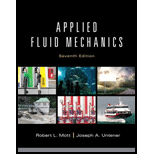
Applied Fluid Mechanics (7th Edition)
7th Edition
ISBN: 9780132558921
Author: Robert L. Mott, Joseph A. Untener
Publisher: PEARSON
expand_more
expand_more
format_list_bulleted
Concept explainers
Textbook Question
Chapter 7, Problem 7.40PP
Evaluate the suitability of the sizes for the suction and discharge lines of the system as compared with Fig. 6.3 in Chapter 6 and the results of Problems 7.35-7.39.
Expert Solution & Answer
Trending nowThis is a popular solution!

Students have asked these similar questions
Question 2
Figure 3 shows the numerical solution of the advection equation for a scalar u along x at three
consecutive timesteps.
1.0
0.8-
0.6-
0.4-
0.2-
0.0-
-0.2-
-0.4-
-0.6
3.0
3.5
4.0
4.5
5.0
5.5
6.0
6.5
Figure 3: Advection equation, solution for three different timesteps.
a) Provide an explanation what conditions and numerical setup could explain the curves. Identify
which of the three curves is the first, second and third timestep.
b) Consider explicit schemes with central and upwind discretisations. Explain how each of these
candidate discretisations could produce the behaviour shown in Figure 3.
c) Determine the CFL number that was used in the simulation for each of the candidate schemes for
all possible updates.
Assume that the timestep and mesh-width used are constant. Read the data to two digits of
accuracy from Figure 4 shown at the end of the question, which is an enlarged version of Figure 3.
Demonstrate your method and input data for one calculation, but then use a…
answer please
Provide an explanation what conditions and numerical setup could explain the curves. Identify which of the three curves is the first. second and third timestep.
Chapter 7 Solutions
Applied Fluid Mechanics (7th Edition)
Ch. 7 - A horizontal pipe carries oil with a specific...Ch. 7 - Water at 40 F is flowing downward through the...Ch. 7 - Find the volume flow rate of water exiting from...Ch. 7 - A long DN 150 Schedule 40 steel pipe discharges...Ch. 7 - Figure 7.14 shows a setup to determine the energy...Ch. 7 - A test setup to determine the energy loss as water...Ch. 7 - The setup shown in Fig. 7.16 is being used to...Ch. 7 - A pump is being used to transfer water from an...Ch. 7 - In Problem 7.815 (Fig. 7.17), if the left-hand...Ch. 7 - A commercially available sump pump is capable of...
Ch. 7 - A submersible deep-well pump delivers 745 gal/h of...Ch. 7 - In a pump test the suction pressure at the pump...Ch. 7 - The pump shown in Fig. 7.19 is delivering...Ch. 7 - The pump in Fig. 7.20 delivers water from the...Ch. 7 - Repeat Problem 7.14, but assume that the level of...Ch. 7 - Figure 7.21 shows a pump delivering 840L/min of...Ch. 7 - Figure 7.22 shows a submersible pump being used to...Ch. 7 - Figure 7.23 shows a small pump in an automatic...Ch. 7 - The water being pumped in the system shown in Fig....Ch. 7 - A manufacturer's rating for a gear pump states...Ch. 7 - The specifications for an automobile fuel pump...Ch. 7 - Figure 7.26 shows the arrangement of a circuit for...Ch. 7 - Calculate the power delivered to the hydraulic...Ch. 7 - Water flows through the turbine shown in Fig....Ch. 7 - Calculate the power delivered by the oil to the...Ch. 7 - What hp must the pump shown in Fig. 7.30 deliver...Ch. 7 - If the pump in Problem 7.26 operates with an...Ch. 7 - The system shown in Fig. 7.31 delivers 600 L/min...Ch. 7 - Kerosene (sg = 0.823 ) flows at 0.060m3/s in the...Ch. 7 - Water at 60 F flows from a large reservoir through...Ch. 7 - Figure 7.34 shows a portion of a fire protection...Ch. 7 - For the conditions of Problem 7.31 and if we...Ch. 7 - In Fig. 7.35 kerosene at 25 F is flowing at 500...Ch. 7 - For the system shown in Fig. 7.35 and analyzed in...Ch. 7 - Compute the power removed from the fluid by the...Ch. 7 - Compute the pressure at point 2 at the pump inlet.Ch. 7 - Compute the pressure at point 3 at the pump...Ch. 7 - Compute the pressure at point 4 at the press...Ch. 7 - Compute the pressure at point 5 at the press...Ch. 7 - Evaluate the suitability of the sizes for the...Ch. 7 - The portable, pressurized fuel can shown in Fig....Ch. 7 - Professor Crocker is building a cabin on a...Ch. 7 - If Professor Crocker's pump, described in Problem...Ch. 7 - The test setup in Fig. 7.39 measures the pressure...Ch. 7 - If the fluid motor in Problem 7.44 has an...Ch. 7 - A village with a need for a simple irrigation...Ch. 7 - As a member of a development team for a new jet...Ch. 7 - A fire truck utilizes its engine to drive a pump...Ch. 7 - A home has a sump pump to handle ground water from...Ch. 7 - In Problem 6.107 an initial calculation was made...Ch. 7 - A creek runs through a certain part of a campus...Ch. 7 - A hot tub is to have 40 outlets that are each 8 mm...Ch. 7 - A large chipper/shredder is to be designed for use...
Knowledge Booster
Learn more about
Need a deep-dive on the concept behind this application? Look no further. Learn more about this topic, mechanical-engineering and related others by exploring similar questions and additional content below.Similar questions
- What are the accompanving boundary conditions for this bar?arrow_forward1.1 Consider the fireclay brick wall of Example 1.1 that is operating under different thermal conditions. The tem- perature distribution, at an instant in time, is T(x) = a+ bx where a 1400 K and b = -1000 K/m. Determine the heat fluxes, q", and heat rates, q, at x = 0 and x = L. Do steady-state conditions exist?arrow_forward2.4 To determine the effect of the temperature dependence of the thermal conductivity on the temperature dis- tribution in a solid, consider a material for which this dependence may be represented as k = k₁ + aT where k, is a positive constant and a is a coefficient that may be positive or negative. Sketch the steady-state temperature distribution associated with heat transfer in a plane wall for three cases corresponding to a > 0, a = 0, and a < 0.arrow_forward
- 1.21 A one-dimensional plane wall is exposed to convective and radiative conditions at x = 0. The ambient and sur- rounding temperatures are T = 20°C and Tur = 40°C, respectively. The convection heat transfer coefficient is h=20 W/m² K, and the absorptivity of the exposed sur- face is α=0.78. Determine the convective and radiative heat fluxes to the wall at x = 0 if the wall surface tem- perature is T, = 24°C. Assume the exposed wall surface is gray, and the surroundings are large.arrow_forward1.12 You've experienced convection cooling if you've ever extended your hand out the window of a moving vehi- cle or into a flowing water stream. With the surface of your hand at a temperature of 30°C, determine the con- vection heat flux for (a) a vehicle speed of 40 km/h in air at -8°C with a convection coefficient of 40 W/m² K and (b) a velocity of 0.2 m/s in a water stream at 10°C with a convection coefficient of 900 W/m²K. Which condition would feel colder? Contrast these results with a heat flux of approximately 30 W/m² under normal room conditions.arrow_forwardPLEASE SOLVE STEP BY STEP WITHOUT ARTIFICIAL INTELLIGENCE OR CHATGPT SOLVE BY HAND STEP BY STEParrow_forward
- 1. A 40 lb. force is applied at point E. There are pins at A, B, C, D, and F and a roller at A. a. Draw a FBD of member EFC showing all the known and unknown forces acting on it. b. Draw a FBD of member ABF showing all the known and unknown forces acting on it. c. Draw a FBD of member BCD showing all the known and unknown forces acting on it. d. Draw a FBD of the entire assembly ADE showing all the known and unknown forces acting on it. e. Determine the reactions at A and D. f. Determine the magnitude of the pin reaction at C. 40 lbs. B A 6 in. 4 in. D F -5 in.4 in 4.arrow_forwardA crude oil of specific gravity0.85 flows upward at a volumetric rate of flow of 70litres per second through a vertical venturimeter,with an inlet diameter of 250 mm and a throat diameter of 150mm. The coefficient of discharge of venturimeter is 0.96. The vertical differences betwecen the pressure toppings is 350mm. i) Draw a well labeled diagram to represent the above in formation i) If the two pressure gauges are connected at the tapings such that they are positioned at the levels of their corresponding tapping points, determine the difference of readings in N/CM² of the two pressure gauges ii) If a mercury differential manometer is connected in place of pressure gauges, to the tappings such that the connecting tube up to mercury are filled with oil determine the difference in the level of mercury column.arrow_forwardCan you solve it analytically using laplace transforms and with Matlab code as well please. Thank Youarrow_forward
- Can you solve it analytically using laplace transforms and with Matlab code as well please. Thank You.arrow_forwardQ11. Determine the magnitude of the reaction force at C. 1.5 m a) 4 KN D b) 6.5 kN c) 8 kN d) e) 11.3 KN 20 kN -1.5 m- C 4 kN -1.5 m B Mechanical engineering, No Chatgpt.arrow_forwardplease help with this practice problem(not a graded assignment, this is a practice exam), and please explain how to use sohcahtoaarrow_forward
arrow_back_ios
SEE MORE QUESTIONS
arrow_forward_ios
Recommended textbooks for you
 Elements Of ElectromagneticsMechanical EngineeringISBN:9780190698614Author:Sadiku, Matthew N. O.Publisher:Oxford University Press
Elements Of ElectromagneticsMechanical EngineeringISBN:9780190698614Author:Sadiku, Matthew N. O.Publisher:Oxford University Press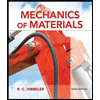 Mechanics of Materials (10th Edition)Mechanical EngineeringISBN:9780134319650Author:Russell C. HibbelerPublisher:PEARSON
Mechanics of Materials (10th Edition)Mechanical EngineeringISBN:9780134319650Author:Russell C. HibbelerPublisher:PEARSON Thermodynamics: An Engineering ApproachMechanical EngineeringISBN:9781259822674Author:Yunus A. Cengel Dr., Michael A. BolesPublisher:McGraw-Hill Education
Thermodynamics: An Engineering ApproachMechanical EngineeringISBN:9781259822674Author:Yunus A. Cengel Dr., Michael A. BolesPublisher:McGraw-Hill Education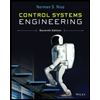 Control Systems EngineeringMechanical EngineeringISBN:9781118170519Author:Norman S. NisePublisher:WILEY
Control Systems EngineeringMechanical EngineeringISBN:9781118170519Author:Norman S. NisePublisher:WILEY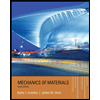 Mechanics of Materials (MindTap Course List)Mechanical EngineeringISBN:9781337093347Author:Barry J. Goodno, James M. GerePublisher:Cengage Learning
Mechanics of Materials (MindTap Course List)Mechanical EngineeringISBN:9781337093347Author:Barry J. Goodno, James M. GerePublisher:Cengage Learning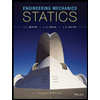 Engineering Mechanics: StaticsMechanical EngineeringISBN:9781118807330Author:James L. Meriam, L. G. Kraige, J. N. BoltonPublisher:WILEY
Engineering Mechanics: StaticsMechanical EngineeringISBN:9781118807330Author:James L. Meriam, L. G. Kraige, J. N. BoltonPublisher:WILEY

Elements Of Electromagnetics
Mechanical Engineering
ISBN:9780190698614
Author:Sadiku, Matthew N. O.
Publisher:Oxford University Press

Mechanics of Materials (10th Edition)
Mechanical Engineering
ISBN:9780134319650
Author:Russell C. Hibbeler
Publisher:PEARSON

Thermodynamics: An Engineering Approach
Mechanical Engineering
ISBN:9781259822674
Author:Yunus A. Cengel Dr., Michael A. Boles
Publisher:McGraw-Hill Education

Control Systems Engineering
Mechanical Engineering
ISBN:9781118170519
Author:Norman S. Nise
Publisher:WILEY

Mechanics of Materials (MindTap Course List)
Mechanical Engineering
ISBN:9781337093347
Author:Barry J. Goodno, James M. Gere
Publisher:Cengage Learning

Engineering Mechanics: Statics
Mechanical Engineering
ISBN:9781118807330
Author:James L. Meriam, L. G. Kraige, J. N. Bolton
Publisher:WILEY
Fluid Mechanics - Viscosity and Shear Strain Rate in 9 Minutes!; Author: Less Boring Lectures;https://www.youtube.com/watch?v=_0aaRDAdPTY;License: Standard youtube license